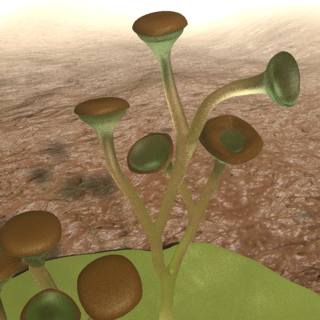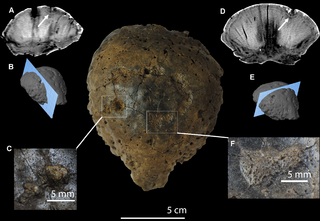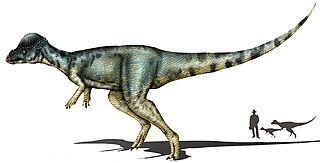
Cooksonia is an extinct group of primitive land plants, treated as a genus, although probably not monophyletic. The earliest Cooksonia date from the middle of the Silurian ; the group continued to be an important component of the flora until the end of the Early Devonian, a total time span of 433 to 393 million years ago. While Cooksonia fossils are distributed globally, most type specimens come from Britain, where they were first discovered in 1937. Cooksonia includes the oldest known plant to have a stem with vascular tissue and is thus a transitional form between the primitive non-vascular bryophytes and the vascular plants.

The rhyniophytes are a group of extinct early vascular plants that are considered to be similar to the genus Rhynia, found in the Early Devonian. Sources vary in the name and rank used for this group, some treating it as the class Rhyniopsida, others as the subdivision Rhyniophytina or the division Rhyniophyta. The first definition of the group, under the name Rhyniophytina, was by Banks, since when there have been many redefinitions, including by Banks himself. "As a result, the Rhyniophytina have slowly dissolved into a heterogeneous collection of plants ... the group contains only one species on which all authors agree: the type species Rhynia gwynne-vaughanii". When defined very broadly, the group consists of plants with dichotomously branched, naked aerial axes ("stems") with terminal spore-bearing structures (sporangia). The rhyniophytes are considered to be stem group tracheophytes.

Hanssuesia is a genus of pachycephalosaurid dinosaurs from the late Cretaceous period. It lived in what is now Alberta and Montana, and contains the single species Hanssuesia sternbergi.

Elmisaurus is an extinct genus of caenagnathid dinosaur from the Late Cretaceous Nemegt Formation of Mongolia. It was a theropod belonging to the Oviraptorosauria.

Alaskacephale was a genus of pachycephalosaurid dinosaur that lived in the late Campanian to Maastrichtian stages of the Late Cretaceous.

Nematothallus is a form genus comprising cuticle-like fossils. Some of its constituents likely represent red algae, whereas others resemble lichens.

Polysporangiophytes, also called polysporangiates or formally Polysporangiophyta, are plants in which the spore-bearing generation (sporophyte) has branching stems (axes) that bear sporangia. The name literally means 'many sporangia plant'. The clade includes all land plants (embryophytes) except for the bryophytes whose sporophytes are normally unbranched, even if a few exceptional cases occur. While the definition is independent of the presence of vascular tissue, all living polysporangiophytes also have vascular tissue, i.e., are vascular plants or tracheophytes. Extinct polysporangiophytes are known that have no vascular tissue and so are not tracheophytes.
Aphrosaurus is an extinct genus of plesiosaur from the Late Cretaceous. The type species is Aphrosaurus furlongi, named by Welles in 1943. Aphrosaurus furlongi was discovered in the Panoche Hills of Fresno County, California in 1939 by rancher Frank C. Piava and named after University of California Berkeley field assistant and specimen preparator Eustace Furlong.
Ogmodirus is an extinct genus of plesiosaur found in the Cenomanian-Turonian Greenhorn Limestone of Kansas. It may be member of the Elasmosauridae, a group of marine animals related to Elasmosaurus, but the condition of the fossils discovered to date means the genus is dubious beyond Plesiosauria. The type species, O. martini, was named by Samuel Wendell Williston and Roy L. Moodie in 1913. The original specimen consisted of a pelvic girdle, limb elements, and more than fifty cervical (neck) vertebrae discovered in Cloud County, Kansas. A second species, Ogmodirus ischiadicus, has since been referred to Styxosaurus. Sepkoski (2002) assigned Ogmodirus to the Plesiosauria.
Goniosaurus is an extinct genus of plesiosaur from the Late Cretaceous of the Nekum Chalk, in Netherlands. The only species so far described, G. binskhorsti is represented only by an isolated, compressed and slender tooth described by Hermman Meyer and a referred tooth and a cervical vertebra that shows that was an elasmosaurid, as many others Late Cretaceous plesiosaurs from Europe.

Tricleidus is an extinct genus of cryptoclidid plesiosaur known from only specimen from the middle Jurassic of United Kingdom. It was first named by Andrews in 1909 and the type species is Tricleidus seeleyi.

Seeleyosaurus is an extinct genus of plesiosaur that was initially placed within the genus Plesiosaurus in 1895 and was given its own genus in 1940. Two species were known: the type, S. guilelmiimperatoris, and the now obsolete species S. holzmadensis, which has since been absorbed into S. guilelmiimperatoris. The holotype was MB.R.1992, a large almost complete skeleton from the Upper Lias (Toarcian) Lias Group Formations of Württemberg, Germany. There seems to be the impression of a rhomboidal flap of skin in a vertical plane; if so, many plesiosaurs may have been equipped in this way. The holotype was destroyed in 1945 (WWII) and only a cast exists today. A second specimen, preserved in 3D, has survived until today. It was once the holotype of the now obsolete species S. holzmadensis.
Aberlemnia is a genus of extinct vascular plants of the Early Devonian, which consisted of leafless stems with terminal spore-forming organs (sporangia). Fossils found in Scotland were initially described as Cooksonia caledonica. A later review, which included new and more complete fossils from Brazil, showed that the specimens did not fit the circumscription of the genus Cooksonia; accordingly a new genus Aberlemnia was proposed.
Macgowania is an extinct genus of parvipelvian ichthyosaur known from British Columbia of Canada.
This timeline of Cambrian research is a chronological listing of events in the history of geology and paleontology focused on the study of earth during the span of time lasting from 541 to 485.4 million years ago and the legacies of this period in the rock and fossil records.
This timeline of Ordovician research is a chronological listing of events in the history of geology and paleontology focused on the study of earth during the span of time lasting from 485.4–443.4 million years ago and the legacies of this period in the rock and fossil records.
This timeline of Silurian research is a chronological listing of events in the history of geology and paleontology focused on the study of Earth during the span of time lasting from 443.4–419.2 million years ago; the Silurian, and the legacies of this period in the rock and fossil records.
This timeline of Carboniferous research is a chronological listing of events in the history of geology and paleontology focused on the study of earth during the span of time lasting from 358.9 to 298.9 million years ago and the legacies of this period in the rock and fossil records.
This timeline of Permian research is a chronological listing of events in the history of geology and paleontology focused on the study of earth during the span of time lasting from 298.9–252.17 million years ago and the legacies of this period in the rock and fossil records.

This timeline of coelophysoid research is a chronological listing of events in the history of paleontology focused on the coelophysoids, a group of primitive theropod dinosaurs that were among Earth's dominant predators during the Late Triassic and Early Jurassic epochs. Although formally trained scientists didn't discover coelophysoid fossils until the late 19th century, Native Americans of the modern southwestern United States may have already encountered their fossils. Navajo creation mythology describes the early Earth as being inhabited by a variety of different kinds of monsters who hunted humans for food. These monsters were killed by storms and the heroic Monster Slayers, leaving behind their bones. As these tales were told in New Mexico not far from bonebeds of Coelophysis, this dinosaur's remains may have been among the fossil remains that inspired the story.














